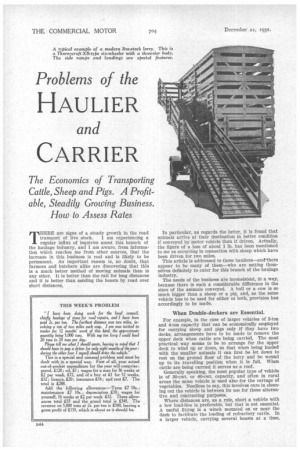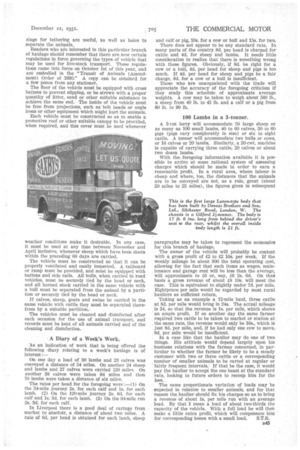Problems of the
Page 58

Page 59

If you've noticed an error in this article please click here to report it so we can fix it.
HAULIER
and
CARRIER
The Economics of Transporting Cattle, Sheep and Pigs. A Profitable, Steadily Growing Business. How to Assess Rates
THERE are signs of a steady growth in the road
transport of live stock. I am experiencing a regular influx of inquiries anent this branch of the haulage industry, and I am aware, from information which reaches me from other sources, that the increase in this business is real and is likely to be permanent, An important reason is, no doubt, that farmers and butchers alike are discovering that this is a much better method of moving animals than is any other. It is better than the rail for long distances and it is better than sending the beasts by road over short distances. In particular, as regards the latter, it is found that animals arrive at their destination in better condition if conveyed by motor vehicle than if driven. Actually, the figure of a loss of about 1 lb. has been mentioned to me as occurring in connection with sheep which have been driven for two miles.
This article is addressed to those hauliers—and there appear to be many of them—who are setting themselves definitely to cater for this branch of the haulage industry.
The needs of the business are inconsistent, in a way, because there is such a considerable difference in the sizes of the animals conveyed. A bull or a cow is so much bigger than a sheep or a pig, and, as the same vehicle has to be used for either or both, provision has accordingly to be made.
When Double-deckers are Essential.
For example, in the ease of larger vehicles of 3-ton and 4-ton capacity that can be economically employed for carrying sheep and pigs only if they have two decks, arrangements have to be made to remove the upper deck when cattle are being carried. The most practical way seems to be to arrange for the upper deck to wind up or down, so that when being loaded with the smaller animals it can first be let down to rest on the ground floor of the lorry and be wound up to its travelling position when it is full. When cattle are being carried it serves as a roof..
Generally speaking, the most popular type of vehicle is of 30-cwt. or 40-cwt. capacity, and often in rural areas the same vehicle is used also for the cartage of vegetables. Needless to say, this involves care in cleaning out the vehicle in between its use for these alternative and contrasting purposes.
Where distances are, as a rule, short a vehicle with a low load-line is preferable, but that is not essential. A useful fitting is a winch mounted on or near the dash to facilitate the loading of refractory cattle. In a larger vehicle, carrying several beasts at a time, rings for tethering are useful, as well as bales to separate the animals. Readers who are interested in this particular branch of haulage should remember that there are now certain regulations in force governing the types of vehicle that may be used for live-stock transport. These regulations came into force on October 1st of this year, and are embodied in the "Transit of Animals (Amendment) Order of 1930." A copy can be obtained for a few pence from any stationer.
The floor of the vehicle must be equipped with cross battens to prevent slipping, or be strewn with a proper quantity of litter, sand or other suitable substance to achieve the same end. The inside, of the vehicle must be free from projections, such as bolt heads or angle irons or other equipment which might hurt the animals. Each vehicle must be constructed so as to enable a protective roof or other suitable canopy to be provided, when required, and this cover must be used whenever weather conditions make it desirable. In any case, it must be used at any time between November and April inclusive, whenever sheep which have been shorn within the preceding 60 days are carried.
The vehicle must be constructed so that it can be properly ventilated and easily inspected. A tailboard or ramp mast be provided, and must be equipped with battens and side rails. All bulls, when carried in road vehicles, must be securely tied by the head or neck, and all horned stock carried in the same vehicle with a bull must be separated from the animal by a partition or securely tied by the head or neck.
If calves, sheep, goats and swine be carried in the same vehicle with cattle they must be separated therefrom by a suitable partition.,
The vehicles must be cleaned and disinfected after each occasion for the use of animal transport, and records must be kept of all animals carried and of the cleaning and disinfection.
A Diary of a Week's Work.
'As an indication of work that is being offered the following diary relating to a week's haulage is of interest: On one day a load of 30 lambs and 23 calves was conveyed a distance of 54 miles. On another 24 sheep and lambs and 27 calves were carried 120 miles. On another 38 calves were taken 94 miles and then 70 lambs were taken a distance of six miles.
The rates per head for the foregoing were :-(1) On the 54-mile journey 2s. for each calf and 1s. for each lamb. (2) On the 120-mile journey 2s. 6d. for each calf and 1s. 3d. for each lamb. (3) On the 94-mile run 2s. 3d. for each calf.
In Liverpool there is a good deal of cartage from market to abattoir, a distance of about two miles. A rate of 6d. per head is obtained for each lamb, sheep
and calf or pig, 10s. for a cow or bull and 15s. for two.
There does not appear to be any standard rate. In many parts of the country 8d. per head is charged for cattle and 4d. for sheep and lambs. It needs little consideration to realize that there is something wrong with these figures. Obviously, if 8d. be right for a cow or a bull, 4d. per head for sheep and pigs is too much. If 4d. per head for sheep and pigs be a fair charge, Sd. for a cow or a bull is insufficient.
Those who are unacquainted with the trade will appreciate the accuracy of the foregoing criticism if they study this schedule of approximate average weights. A cow may be taken to weigh about 560 lb., a sheep from 40 lb. to 45 lb. and a calf or a pig from 80 lb. to 90 lb.
100 Lambs in a 3-tonner.
A 3-ton lorry will accommodate 50 large sheep or as many BS 100 small lambs, 40 to 60 calves, 30 to 60 pigs (pigs vary consWerably in size) or six to eight cattle. A tonner will accommodate two bulls or cows, or 16 calves or 20 lambs. Similarly, a 30-cwt. machine is capable of carrying three cattle. 20 calves or about two dozen lambs.
With the, foregoing information available it is possible to arrive at some rational system of assessing charges which should be made in order to earn a reasonable profit. In a rural area, where labour is cheap and where, too, the distances that the animals are to be conveyed are not, as a rule, great (about 20 miles to 25 miles), the figures given in subsequent paragraphs may be taken to represent the economics for this branch of haulage.
The owner of the vehicle will probably be content with a gross profit of £2 to £2 10s. per week. If the weekly mileage be about 300 the total operating Gost, allowing for the fact• that such items as wages, maintenance and garage rent will be less than the average, will approximate to 1.6 or, say, £6 2s. 6d. On that basis a gross revenue of about 18 10s. will meet the case. This is equivalent to slightly under 7d. per mile. Eightpence per mile would be regarded by most rural • hauliers as sufficient return.
Taking as an example a 12-mile haul, three cattle at 8d. per mile would bring in 24s. The actual mileage is 24, so that the revenue is Is. per mile, which shows an ample profit. If on another day the same farmer ; required two cattle to be taken to market or station at . the same rate, the revenue would only be 16s., which is just 8d. per mile, and, if he had only one cow to move, 8d. per mile would he insufficient.
' In a case like that the haulier may do one of two things. His attitude would depend largely upon his business relations with the farmer concerned, in par. ticular to whether the farmer be likely to be a steady customer with two or three cattle or a corresponding number of smaller animals to be carted at regular or fairly frequent intervals.If that be the case, it would pay the haulier to accept the one beast at the standard rate, looking to future orders to recoup him for the loss, The same proportionate variation of loads may be expected in relation to smaller animals, and for that reason the haulier should fix his charges so. as.to bring a revenue of about is. per mile run with an average load. By that I mean a load of about two-thirds the capacity of the vehicle. With a full load he will then make a little extra profit, which will compensate him
for corresponding losses with a small load. S.T.R.




























































































